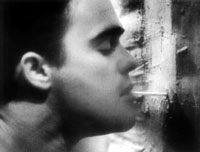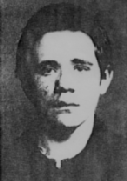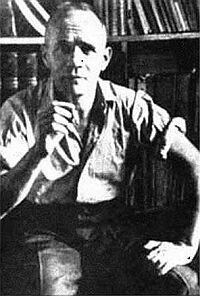







Genet: Un Chant d'amour

F 1950, 20 min
Regie: Jean Genet
Drehbuch: Jean Genet
Darsteller: Java, André Reybaz, Lucien Senemaud, u.a.
Synopsis
Ein Aufseher nähert sich einem Gefängnis. Sein Blick fällt auf einen Blumenstrauß, der von einem vergitterten Fenster zum nächsten geschwungen wird, ohne daß er vom Arm des Empfängers gegriffen werden kann. Das Interesse des Aufsehers ist geweckt: er beginnt die einzelnen Gefangenen in ihren Zellen durch den Türspion zu beobachten, was den Voyeur sichtlich erregt. Besondere Aufmerksamkeit widmet er dem stummen Dialog eines aufgewühlten Gefangenen mit seinem offenbar desinteressierten Zellennachbar durch eine Wand hindurch. Diese Wand selbst wird zum Objekt der Begierde, geküsst, geschlagen, durchbohrt. Die beiden Männer tauschen Zigarettenrauch über einen Strohhalm durch ein kleines Loch in der Wand aus. Dies wiederum beflügelt die Phantasie des Aufsehers. Er betritt schließlich die Zelle des älteren Gefangenen und mißhandelt diesen frustriert. Der Insasse flüchtet sich in eine romantische Phantasie, in der er sich seinem Zellengenossen in der freien Natur hingibt. Als der Aufseher schließlich das Gefängnis wieder verläßt, sieht er nicht, wie der schwingende Blumenstrauß schließlich gefangen wird.
Un Chant D'Amour gilt als Meilenstein schwuler Filmkunst und Ästhetik. Genets einziger Film beruht auf seinem Mauskript Notre-Dame-des-Fleurs, das er während eines langjährigen Gefängnisaufenthalts schrieb. Immer wieder fängt die Kamera Fragmente der männlichen Körper in Großaufnahmen ein. Genet fetischisiert seine Protagonisten: Arme, Hände, Gesichter, Oberkörper werden in weichem Licht inszeniert. Diese Aufnahmen stehen in hartem Kontrast zur brutalen und freudlosen Welt des Gefängnisses, so daß sich der narzisstische Selbstbezug der Insassen in einem stummen "Lied der Liebe" mit Bildern von Einsamkeit, Frustration und Verlangen verbindet. Enge und Weite, Strenge und Verspieltheit mischen sich in diesem Filmgedicht mit dem sadistischen Voyeurismus des Aufsehers (und des Publikums), und erzeugen so eine Spannung aus Tod, Macht und Leidenschaft.
Genets Bilder sind zugleich äußerst dinglich und äußerst symbolisch. Ihre Intensität geht aber nicht so sehr vom Symbolischen, vom Mit-Gemeinten aus, als vielmehr vom Dinglichen: von den Wänden, der Haut, den Bartstoppeln, den wollenen Pullovern. Dazwischen gibt es Träume unter blühenden Bäumen, hängende Blumengebinde, sehnsuchtsvoll greifende Hände, Symbolismen, die im Film gewöhnlich dann kommen, wenn der Filmemacher nicht mehr weiterweiß, wenn er sich flüchten muß in Vieldeutigkeit.
In Genets Film aber steht das alles in einem Zusammenhang, der die übliche Verwendung zerschlägt, der Symbol und Traum als das darstellt, was es ist: Flucht aus der Erniedrigung. Erotische Verhältnisse sind, wie immer bei Genet, Machtverhältnisse. Im Glück zeigt sich die Überlegenheit des Stärkeren darin, daß er den Geliebten trägt (wie in der Traumsequenz). Im Unglück in der vergeblichen-verklemmten Liebe träumt der Aufseher davon, daß der Gefangene sein Machtsymbol, seinen Ersatz-Penis, in den Mund nimmt: die Pistole. Genet zeigt die Unterdrückung und die nutzlosen, lächelnden Ausflüchte in den Traum. Er zeigt, was Gefangenschaft ist.
Zur Musik
Der Film Un Chant d'Amour von Jean Genet ist 1950 entstanden, zu einer Zeit also, in der man in der Regel keine Stummfilme mehr produzierte. Genet wollte ihn ohne Musik haben. Für András Hamary, Pianist, Komponist und Dirigent aus Budapest, ist das ein Gebot, etwas von der Gespanntheit der Stille, die diesen Film bisher umgab, zu wahren. Auch der Titel verpflichtet: der Gesang zweier Instrumente, die sich kaum je richtig werden vereinigen können, ein Gesang verhinderter Liebe in einem feindlichen Umfeld.
Die Musik geht oft ihre eigenen Wege und trennt sich von der Leinwand. Immer jedoch speist sie sich aus Zärtlichkeit und aus Gewalt, durch die sich Sexualität in diesem Film manifestiert. (Auftragskomposition der StummFilmMusikTage Erlangen)
(http://www.stummfilmmusiktage.de/german/Chant%20d'Amour.htm)

Silent witness
Jean Genet's love of cinema lasted his entire life and influenced all his creative work. So why did he make only one movie?
In the era before television, the cinema was the only dramatic art form available to the poor. Jean Genet was extremely poor - a foundling brought up by foster parents in the village of Alligny in the Morvan, a remote rural area in France so impoverished that it survived only by raising cattle and sending its young women off to Paris as wet nurses. But even in Alligny a travelling company set up a screen from time to time and showed silent films. Genet lived in the village from shortly after his birth in 1910 until his departure some 12 years later.
Genet kept coming back imaginatively to the cinema and/or the village in his work. By the time in the early 1940s when he was working on Our Lady of the Flowers , his first novel, he had already written several plays and at least one film script. (They have been lost, and we know little about their contents.) In Our Lady, much of the action occurs in the village where a lonely, poetic boy - who will grow up to be Divine, the drag queen and prostitute - is in love with a snake tamer. There are ecstatic descriptions of people and places right out of Genet's village life.
In his novel Funeral Rites, the action begins at a cinema as a French audience watches a newsreel and reviles the militiamen shown on screen, traitors collaborating with the Nazis. And in 1947 Genet was apparently working on a script called The Revolt of the Black Angels based on his childhood. The film was never made, and the script has been lost.
In 1950 he directed his only film, n Chant d'Amour, and though it had a large budget and was shot in highly controlled circumstances, Genet - this master of words, this silver-tongued novelist - decided to make it a silent film. Though it is a prison film, the fantasy romantic sequences between two of the prisoners were shot in the countryside. The location was near Cocteau's country house at Milly-la-Forêt, but the hills and flowering trees seem characteristic of anywhere in northern France, and certainly don't "read" as somewhere as built-up as that area actually is. The blossoming branch shown emerging out of the older prisoner's chest is an image Genet borrowed from his own novel Querelle; certainly the contrast between a tough sailor or prisoner and an extravagantly beautiful branch of flowers is typical of Genet, just as the play of the branch's shadow on the younger prisoner's puckered lips is symbolic of fellatio.
If Genet chose to make his one and only film silent, that is consistent with his desire to reinvent himself over and over again. His poetry is non-narrative and derived from Cocteau's "surrealist-lite" verse. His three full-length plays never deal with the subject of homosexuality, though that is the unique focus of his novels. His last book, published posthumously in 1986, The Prisoner of Love, is a non-fiction, non-linear memoir that treats politics (the Black Panthers and the Palestinians) in a prose that in no way resembles the language of his novels.
In other words, Genet was constantly evolving and never repeating himself. In his last years, he told an Austrian journalist that he never reread himself nor wanted to discuss his earlier works because he didn't want to resemble himself. Thus it is only consistent with this policy that Genet's one film should be silent and, like the films he saw as a boy, black and white, gestural, mannered, even melodramatic.
Of course, there is some continuity in his concerns - inevitably, since he was one man and he had a deep but limited number of themes to which he responded. Indeed, a close look at his novels reveals that he was profoundly influenced by the cinematic. Jean Genet was interested in the cinema from the very beginning of his career as a writer. Whereas Jean-Paul Sartre postulates that Genet progressed from the solipsism of lyric poetry to progressively more social (and socially concerned) forms of fiction, drama and film, by 1942 Genet had already completed Our Lady of the Flowers and a first draft of his play Deathwatch (called Pour la Belle ). He was also hoping to direct a film.
A close look at the composition of his novels reveals that he was profoundly influenced by the cinematic techniques of collage, flashback and close-up. Just as Un Chant d'Amour intercuts the warder's sexual fantasies with realistic scenes of the prisoners in their cells as well as one prisoner's daydream of a woodland erotic romp, each of the five novels juxtaposes two or three separate plots. For instance, in Our Lady, Divine's life in Montmartre as a transvestite prostitute is interpolated with scenes of his life as the boy Culafroy in a village, and also with scenes of Our Lady's crimes and trial. In a characteristically cinematic rearrangement of sequence, the novel begins with Divine's death and interment, then leads us through his life and hundreds of pages back to this conclusion.
Close-ups of gestures are also essential to Genet's conception of the novel, since in his ontology accidents determine fate, gestures form character and costume triggers events. A Genet film script states: "In effect the cinema is basically immodest. Let us use this faculty to enlarge gestures. The cinema can open a fly and search out its secrets..."
Un Chant d'Amour , the only film Genet both wrote and directed, reveals in a pure form the techniques he adopted to fiction and the theatre. In addition, this film shows his lyric vision of homosexual love, at once highly physical and romantic. Like the photographer Robert Mapplethorpe, who knew of Genet through the singer Patti Smith, Genet presents acts of homosexual love in a light that seems at once offensive to the naive and ennobling to the initiated. Neither Genet nor Mapplethorpe, however, could be considered sexually stimulating, since both make abstractions out of the male body.
Genet never completely resolved, even in his own mind, to what degree his writing was pornographic. Our Lady of the Flowers was originally published in 1943 in a limited deluxe edition intended primarily for the homosexual market. When the same text was later reprinted by Gallimard for the general public, Genet removed many shocking details (such as the dimensions of the characters' penises). Many years later, he was capable of asking a friend if he regarded his work as mere pornography.
Genet maintained an unstable relationship with all of his work. He did not let Nico Papatakis make a film out of his one-act play The Maids because one of his female friends had convinced him the text was badly "dated", although he endorsed Les Abysses, Papatakis's filmed version of the original real-life murder and trial that had inspired the play.
Similarly, Genet was certain his poetry was valueless, and constantly asked friends if they thought his fiction would live. He disliked the end of The Balcony, and long after The Screens was premiered he was still tinkering with the script. His rejection of Un Chant d'Amour may have had its roots in his fear that it, too, was botched or that it was merely pornographic. Certainly by the time he denounced it definitively in the 1970s he had written several other film scripts, and his ideas about cinema as an art had evolved. Perhaps he feared the short early film would be considered amateurish and would compromise his chances to find funding for new projects. (Some of these projects could be extravagant, as the late scenarios reveal.) In the case of La Nuit Venue, Genet worked with a collaborator on a full-length fiction scenario over a long period and through several drafts, only to block the production himself when everything was ready to go.
The curious thing is that Genet thought about cinema early and late throughout his long writing career. He wrote more pages of film scenarios than he did of any other literary genre. But Un Chant d'Amour is the only testimony we have of what his cinematic taste and style might render.
To some extent, it may be seen as a response to Cocteau. In 1943 Genet had been discovered and launched by Cocteau, who arranged for Our Lady of the Flowers to be published and who circulated the manuscript among many important Parisian writers and taste-makers. In the 1940s Cocteau, who was living with film actor Jean Marais, was involved with many major film projects, including most notably his postwar international success, La Belle et la Bête. Genet watched Cocteau's activity with a mixture of envy, admiration and irritation. Indeed, in the early 1950s, Genet, assuming what Cocteau called a "Jansenist" stance, denounced Cocteau for his disgusting involvement with the "industrial cinema".
Could it be that Un Chant d'Amour might be seen both as an echo of Cocteau's mythic, magical cinema and as a criticism of its crowd-pleasing use of linear narration, traditional plot and famous actors? As the sole realisation of Genet's persistent love of the movies, Un Chant d'Amour is an unclaimed pledge in the vast pawnshop of his imagination.
This is an edited extract from Edmund White's introduction to Criminal Desires: Jean Genet and Cinema by Jane Giles, published by Creation Books on October 24, priced £11.99.
(Edmund White, Saturday October 5, 2002 /The Guardian http://books.guardian.co.uk/Print/0,3858,4514539,00.html)

BIOGRAPHY:
Jean Genet was born in Paris, France on December 19, 1910.
He grew up in reform school for selling drugs and engaging in prostitution.
1948 - He was sentenced to prison as a habitual criminal.
He was an author, poet and playwright.
He was friends with Jean-Paul Satre and Jean Cocteau.
He died on April 15, 1986, in Paris, France
French novelist, playwright and poet Jean Genet was born in Paris on December 19, 1910. Abandoned by his parents, he spent much of his youth in an institution for juvenile delinquents. At the age of ten, he was accused of stealing. Although innocent of the charge, having been described as a thief, the young boy resolved to be a thief. "Thus," wrote Genet, "I decisively repudiated a world that had repudiated me."
Between 1930 and 1940, he wandered through various European countries, living as a thief and male prostitute. Eventually, he found himself in Hitler's Germany where he felt strangely out of place. "I had a feeling of being in a camp of organized bandits. This is a nation of thieves, I felt. If I steal here, I accomplish no special act that could help me to realize myself. I merely obey the habitual order of things. I do not destroy it." So Genet hastened on to a country that still obeyed a more conventional moral code.
In 1943, after being imprisoned for theft, Genet began writing. Ignoring traditional plot and psychology, Genet's plays rely heavily on ritual, transformation, illusion and interchangeable identities. His experiences in prison would inform much of his work. The homosexuals, prostitutes, thiefs and outcasts of his plays are trapped in self-destructive circles. They express the despair and loneliness of a man caught in a maze of mirrors, trapped by an endless progression of images that are, in reality, merely his own distorted reflection.
Genet's first dramatic effort is a poignant examination of the oppressed and the oppressor. In Deathwatch he experiments with a murderer in the role of hero. The play revolves around three inmates who struggle for domination of a prison cell while an unseen fourth prisoner watches on.
In his next play; The Maids, Genet portrays a ritualistic act of two maids who take turns acting as "Madame," abusing each other as either servant or employer. The ceremony reveals not only the maids' hatred of the Madame's authority, but also their hatred of themselves for participating in the hierarchy that oppresses them.
First staged at a private club in London because it was considered too scandalous for Paris audiences, The Balcony is set in a brothel of "nobel dimensions," a palace of illusions in which men can indulge their secret fantasies, perhaps as a judge inflicting punishment on a beautiful thief, or as a dying Foreign Legionaire being succoured by a beautiful Arab maiden. But outside the brothel, the country is caught up in the throes of revolution, and these false roles become confused with the real roles of "bishop," "judge" and "general" until nothing is certain.

In The Blacks, a troupe of colored actors enacts before a jury of white-masked blacks the ritualistic murder of a white of which they have been accused. The last of Genet's plays to be produced during his lifetime, The Screens, is his comment on the Algerian revolution. Like all of Genet's works, these plays are grotesque, sometimes bewildering, savage, and haunting. Simultaneously cultivating and denouncing the stage illusion, they exude a strange ritualistic, incantatory quality that successfully transforms life into a series of ceremonies and rituals that bring stability to an otherwise unbearable existence.
In addition to his plays, Genet wrote several novels and film scripts. He also produced a silent picture, Un Chant D'Amour (1949). Genet died in Paris on April 15, 1986.
genet2.jpg+
�
Navigation: | Swiki Top | Lebensreform | Inhalt |
Link to this Page
- MATERIALIEN last edited on 11 July 2006 at 9:29 pm by e176064196.adsl.alicedsl.de




